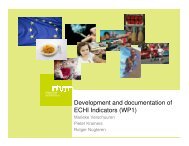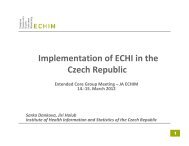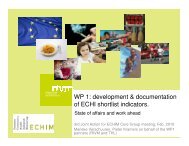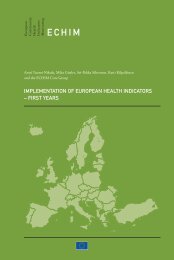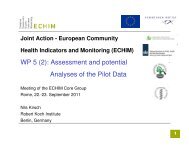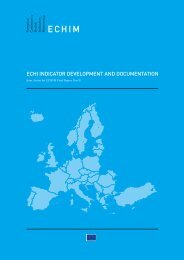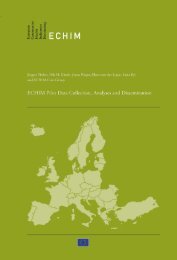INDICATORS
ECHIM Final Report
ECHIM Final Report
Create successful ePaper yourself
Turn your PDF publications into a flip-book with our unique Google optimized e-Paper software.
Relevant<br />
dimensions<br />
(subgroups)<br />
(preferred)<br />
data source(s)<br />
Rationale<br />
Data<br />
availability,<br />
quality,<br />
periodicity<br />
References<br />
Work to do<br />
As a summary, the OECD indicator should be reported for all countries in<br />
which it is available. In addition, the EUROCISS indicators should be reported<br />
for the countries for which they are available, and their availability should be<br />
promoted.<br />
Also the conclusion of the OECD Health Care Quality Indicators Project<br />
with regard to the indicator “AMI and stroke 30-Day Case-Fatality Rate/In-<br />
Hospital Mortality Rate” is “Report in-hospital mortality for all countries for<br />
comparability reasons until the majority of countries is able to calculate the<br />
true 30-day case-fatality rate”.<br />
Country (also region), calendar year, sex.<br />
1) OECD, based on national hospital discharge records and hospital registers.<br />
2), 3) The EUROCISS and Euphoric definitions require a linkage between the<br />
hospital discharge records and the mortality register.<br />
An indicator for the adequacy of AMI and stroke treatment, for AMI especially<br />
in the acute phase. Note however, that early access to hospital both improves<br />
the success of treatment and tends to increase the case fatality because many<br />
of the subjects who will die early will reach the hospital before the death. AMI<br />
and stroke 30-Day Case-Fatality Rate/In-Hospital Mortality Rate are both<br />
included in the OECD set of Health Care Quality Indicators.<br />
– OECD Health Data: reports data for 23–24 countries.<br />
– OECD Health Care Quality Indicators Project report (Health Care Quality<br />
Indicators<br />
Project - Initial Indicators Report) presents data for 17–20 European countries.<br />
– Eurostat, WHO HfA: no data.<br />
– OECD Health Care Quality Indicators project note: the main problems in<br />
cross-country comparisons: Some data are drawn from samples of patient records,<br />
some from all patients. Some countries use unique patient IDs (allows identifying<br />
hospital readmissions) some not. Some countries are able to track patient after<br />
hospital discharge, some are not. Data are available for different years.<br />
– Results from MONICA project indicate that a higher percentage of<br />
women reach hospital alive, but a higher percentage of men survive after<br />
hospitalisation, making the overall 28-day case-fatality very similar between the<br />
sexes.<br />
– EUROCISS project: www.cuore.iss.it/eurociss/<br />
– EUROCISS 2003 report:<br />
www.cuore.iss.it/eurociss/en/project/report2003.asp<br />
– OECD Health Care Quality Indicators project:<br />
www.oecd.org/health/hcqi and<br />
the publication. “Health Care Quality Indicators Project - Initial Indicators<br />
Report” (OECD Health Working Papers no. 22/2006:<br />
www.oecd.org/dataoecd/1/34/36262514.pdf<br />
- European Public Health Outcome Research and Indicators Collection, The<br />
EUPHORIC Project: www.euphoric-project.eu<br />
- Genetic regulation of the end-stage clotting process that leads to thrombotic<br />
stroke, EuroClot: www.euroclot.eu/<br />
46



